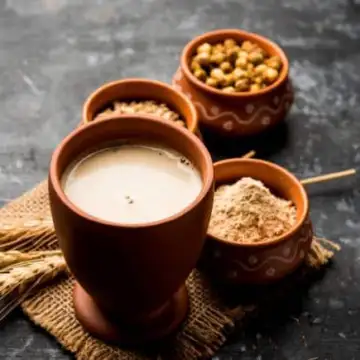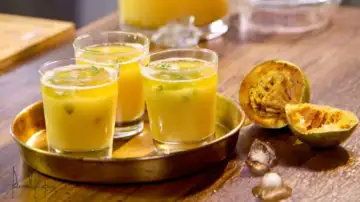
“Aam Panna improves digestion as it is rich in fibre and vitamin B that cleans the intestines. The best time to have it is in the late afternoon as a refreshing drink. Instead of buying packaged aam panna, which contain a lot of processed sugar, try to make it at home. Just add raw mango pulp to water depending on the consistency you like and add brown sugar, salt, mint leaves, roasted cumin powder and ice,” says nutritionist Shweta Shah, founder of Eatfit24/7. The colour of the panna may vary from light green to yellow to light brownish depending on the variety of mangoes used and the method of extracting the pulp, from simply boiling or stove/open fire-roasting the green mangoes.
Jal Jeera Summers in India are synonymous with this incredibly refreshing cooler. The main ingredients of jal jeera are mango powder (aamchoor), black salt, cumin, ginger and lemon. These spices together work to refresh and keep you hydrated during a hot summer day. It is especially popular in north India where one can often spot handcarts with giant clay matkas wrapped with a cloth selling chilled jal jeera garnished with mint leaves and boondi.
The black salt or rock salt added in the drink acts as a good digestive, fresh mint and coriander leaves regulate the body temperature and keep it cool while ginger treats nausea that often accompanies a heatwave. Sol Kadhi What’s not to like about a tantalising mix of kokum (a plant of the mangosteen family) with coconut milk and spices? This very tart and refreshing drink is a speciality of the Konkan region that extends from Goa through Maharashtra. The kokum fruit is largely grown in this belt and used as a souring agent in many of the dishes.
Sol Kadhi cools down the digestive system after eating spicy food. Kokum itself is supposed to be an excellent antidote for acidity. But, it is addictive, don’t go overboard drinking it. Sattu Sharbat Sattu sharbat This lip-smacking drink from Bihar keeps the body cool even during the sunniest day.
Sattu sharbat This lip-smacking drink from Bihar keeps the body cool even during the sunniest day.
It is made with sattu flour (roasted chana) which is easily digestible and provides a burst of instant energy to the body. What’s more, the flour is a great source of vegan protein (100g has a little over 20g of protein), making it a great base for a post-workout meal or drink. “The drink is wholesome, filling and acts as a replacement for meals during hot days when one doesn’t have a big appetite for lunch. It is high on protein and fibre from the sattu and keeps the stomach full for longer,” says Divya Johry, co-founder of Saundha, a Mumbai-based home kitchen serving rustic Bihari food.
Johry likes to spike her sattu sharbat with lemon juice, roasted cumin powder, finely chopped green chilies and a pinch of black pepper. Ragi Ambali This summer drink made from fibre-rich ragi is popular in several parts of Karnataka, especially in the north. The drink is prepared by cooking ragi flour in water and then cooling it down and adding diluted beaten curd or buttermilk to it, along with cumin powder, salt and chopped onions. The drink is topped with a tempering of mustard seeds and curry leaves.
There is also a sweet version with milk and jaggery. “Ragi is a rich source of calcium, iron and fibre that are important for maintaining overall health and immunity. Being gluten-free, it is an excellent choice for people with gluten intolerance or celiac disease. The high fibre content aids digestion, relieves constipation, and reduces cravings, making it an ideal beverage for weight management.
You can have it any time of the day, but it is particularly beneficial in the morning or as a mid-day snack as it provides sustained energy and keeps you full for longer,” says Kajal Aggarwal, dietician and clinical nutritionist. Chhaas / More (Buttermilk)  Buttermilk is a refreshing summer coolant. (Photo: Mario Raj via Unsplash) This one drink unites north and south India in the summer months, though the fermented drink is savoured across south India all through the year. Every southern state has its very own version of the drink.
Buttermilk is a refreshing summer coolant. (Photo: Mario Raj via Unsplash) This one drink unites north and south India in the summer months, though the fermented drink is savoured across south India all through the year. Every southern state has its very own version of the drink.
Known as chhaas in the north, moru in Tamil Nadu, sambharam in Kerala, and majjiga in Andhra Pradesh, it is known for its probiotic qualities. During the pandemic, a turmeric and mint version of the sambharam was in vogue as an immunity drink. In Kerala, sambharam is made from sour curd and is seasoned with ginger, curry leaves, green chilies and shallots while the Tamil version has a tempering of cumin, mustard, crushed curry leaves, ginger bits and asafoetida in hot ghee. Gondhoraj Ghol This classic Bengali delight features fresh curd, sugar, black salt, iced water and the pulpy juice of Bengal’s highly prized Gondhoraj lime.
Loaded with the goodness of vitamin C, antioxidants, probiotic bacteria, cooling spices and herbs, Gondhoraj Ghol is the perfect summer coolant. The wondrous, oval-shaped lime lends an exotic twist to the drink. Kokum Sharbat A refreshing summer drink made from tart kokum, cumin and black salt? We are already drooling!
According to Aggarwal, kokum is cooling in nature, which makes it an ideal drink to soothe the digestive system after fasting during Ramzan. “Kokum is also a functional food that reduces inflammation, improves digestion, and lowers cholesterol levels,” she adds. You can make the kokum concentrate which can then be stored for two-four weeks in the fridge. Bael (wood apple) Sharbat  Bael ka sherbet (Photo courtesy Chef Kunal Kapoor) Also known as Bellada Hannu in Kannada and Maredu in Telegu, bel/baelsharbat is said to cure everything from heatstroke and upset tummy to dehydration and diabetes. But the most compelling reason to devour this tantalising drink is its taste – sweet, sour and woody.
Bael ka sherbet (Photo courtesy Chef Kunal Kapoor) Also known as Bellada Hannu in Kannada and Maredu in Telegu, bel/baelsharbat is said to cure everything from heatstroke and upset tummy to dehydration and diabetes. But the most compelling reason to devour this tantalising drink is its taste – sweet, sour and woody.
“Once you’ve broken through its woody outer shell, soak the pulp in water for an hour. You can then use a masher to mash the pulp. Never grind it in a blender as it will turn bitter because of the seeds. Lastly strain the pulp and serve over ice,” says home chef Nisha Madhulika.
“Bael is highly hydrating in the summers. The vitamin B and C and beta carotene present in the fruit help fight common disease-causing bacteria in the body. You could add some cumin powder and black salt to make it even more nutritious,” suggests Shah. Panagam This simple jaggery drink is immensely popular among the Telugu-speaking community and is served as a welcome drink at weddings and pooja. Panagam in Sanskrit translates to a “sweet drink”. Simply put, it’s water sweetened with jaggery, and flavoured with crushed cardamom and spiced with dry ginger powder and ground black pepper. In Andhra Pradesh, Karnataka and Tamil Nadu large pots of panagam are offered to lord Rama during Rama Navami which is later distributed among the devotees.




 Driving Naari Programme launched in Chandigarh
Driving Naari Programme launched in Chandigarh






























